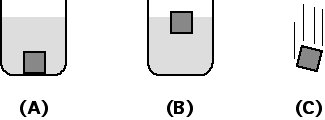A2L Item 053
- Description: Compare the gravitational force on identical blocks in different situations.
- Goal: Hone the concept of force.
- Source: UMPERG
- Keywords: Forces, Mechanics
The question for students:
Consider three identical blocks as shown below. In case A the block sits on the bottom of a beaker filled with oil. In case B the block floats on water. In case C the block is free-falling.

Which block or blocks experience the smallest gravitational force?
- Block A
- Block B
- Block C
- Blocks A and B
- Blocks A and C
- Blocks B and C
- They all experience the same gravitational force
- None of the above
- Cannot be determined
Commentary for teachers:
Answer
(7). The gravitational force is approximately the same for all three blocks assuming that they are about the same height above the surface of the earth. The gravitational force on an object near the surface of the earth depends only on the mass of the object.
Background
Students’ models concerning what factors influence a force can be quite complex. Introducing students to a force law (conceptually or mathematically) is usually not enough to correct any false associations. Only through discussion of the force law in a variety of contexts will the student develop a model more consistent with the physicists’ model.
Questions to Reveal Student Reasoning
What causes the gravitational force? What are some factors that influence the gravitational force? Make a list. What is the gravitational force law? Which of the listed factors are contained in the force law?
Suggestions
What would be the gravitational force on the block if it were sitting on a table?
Suppose the block was falling through oil or that you dropped the beaker in case A. Would the gravitational force change?